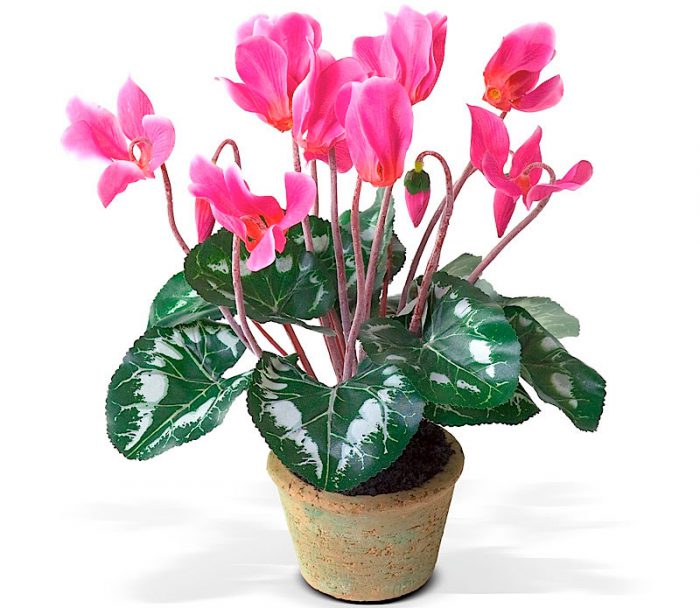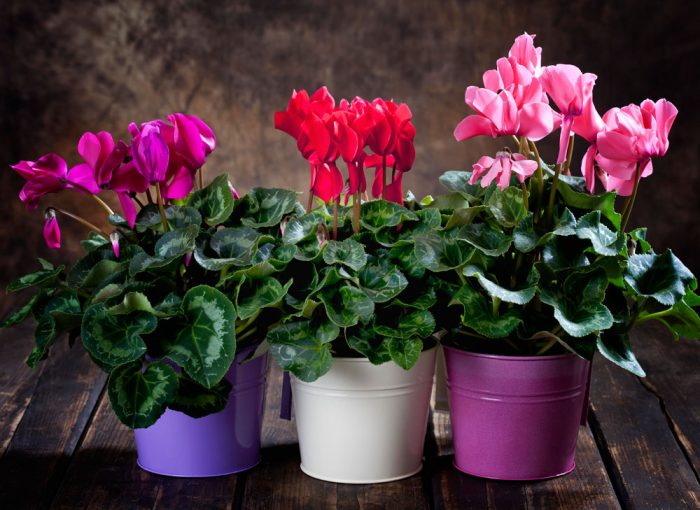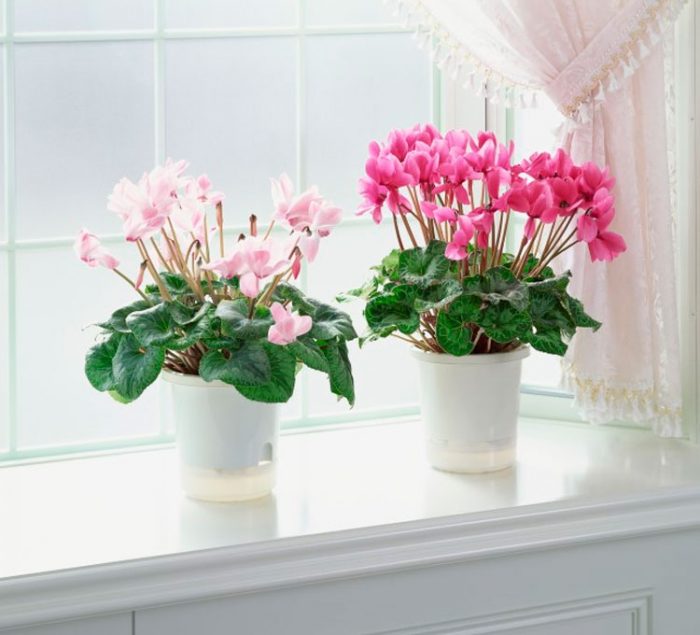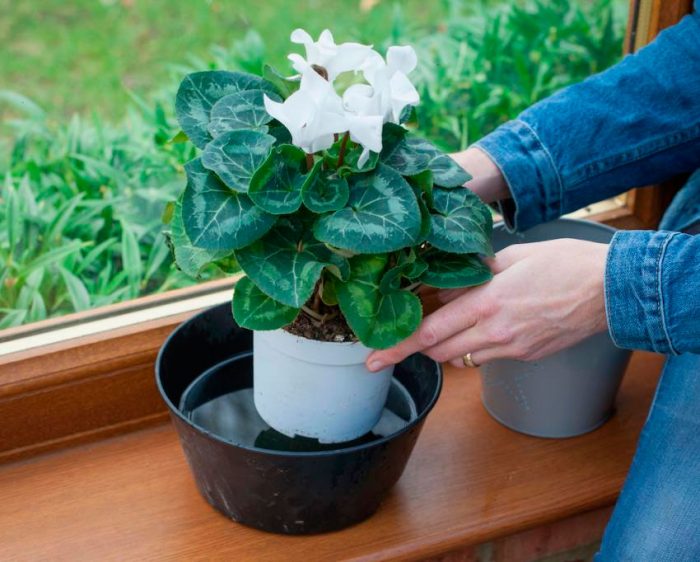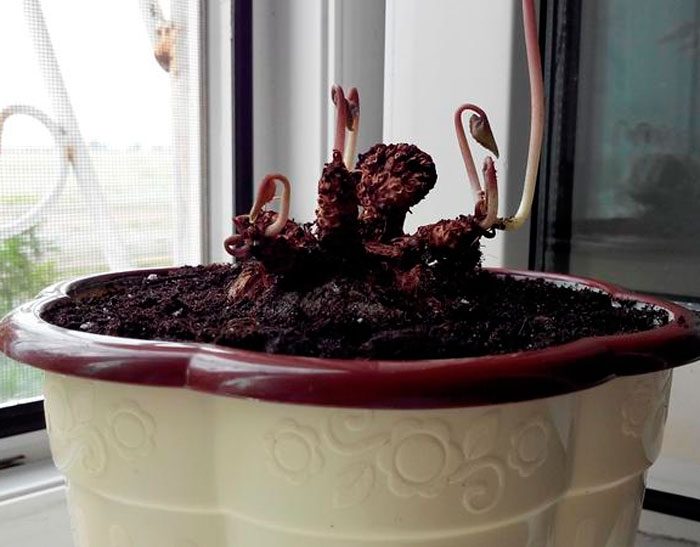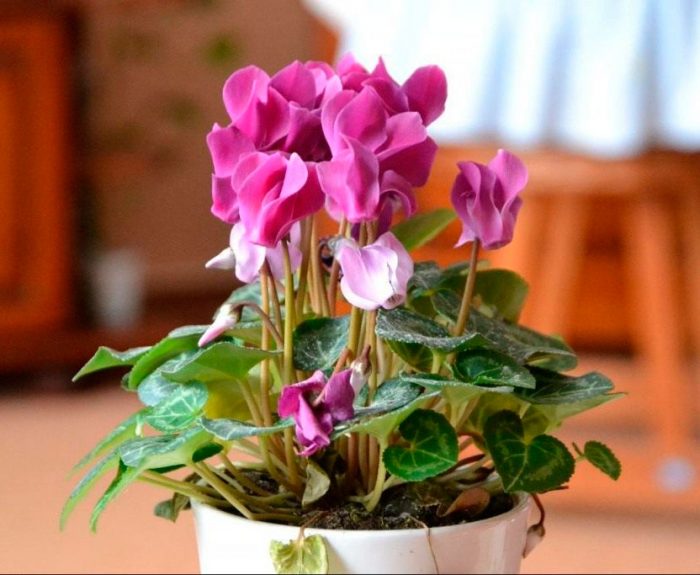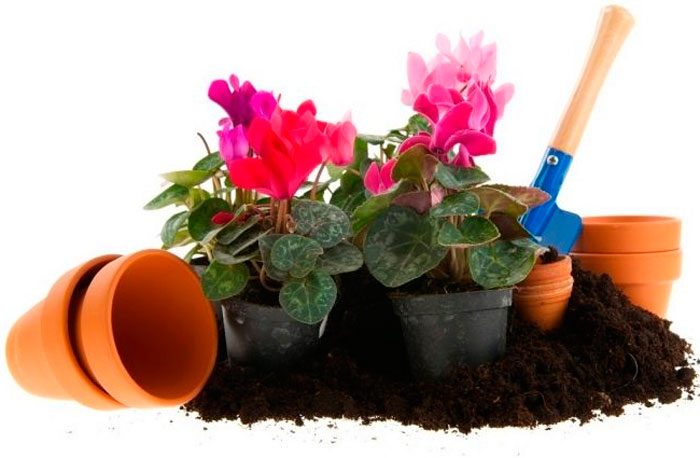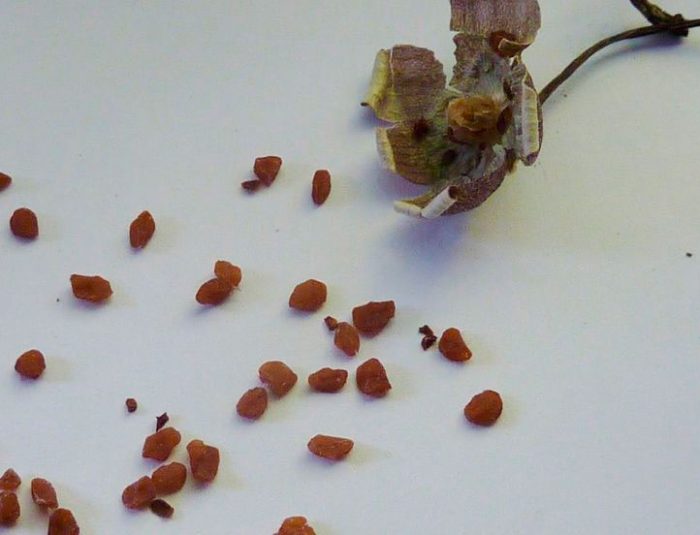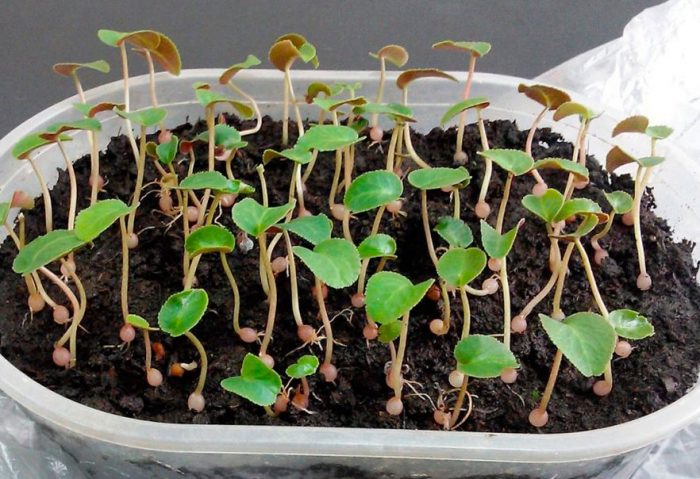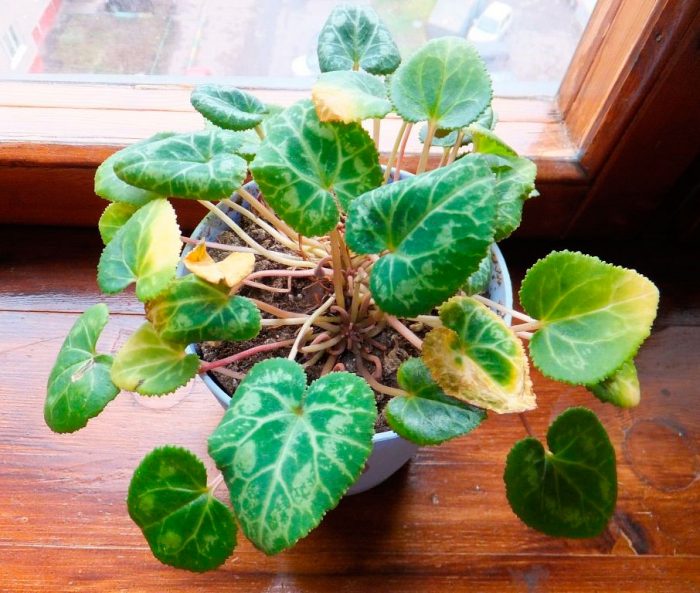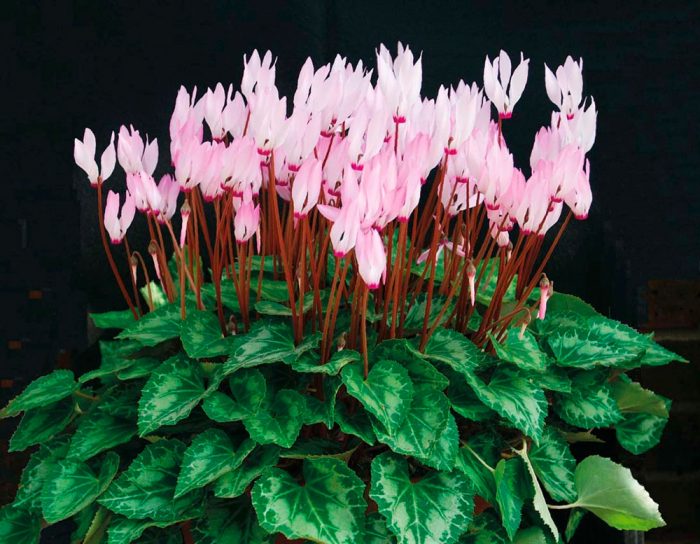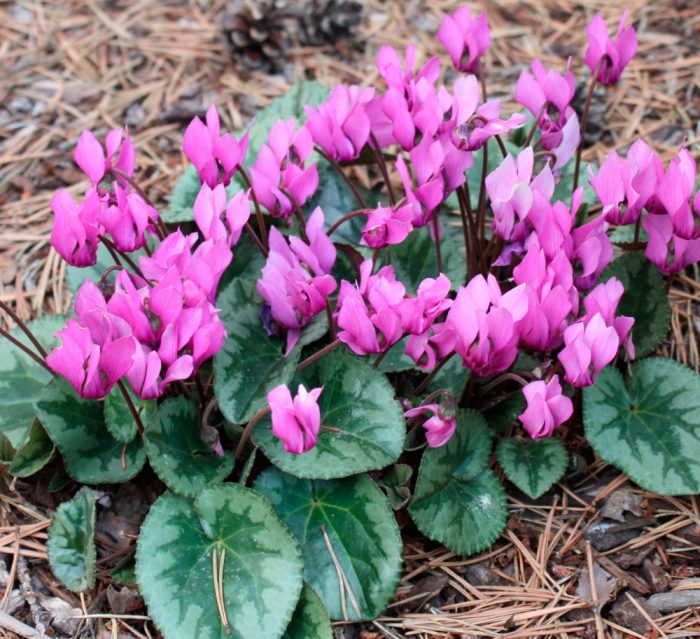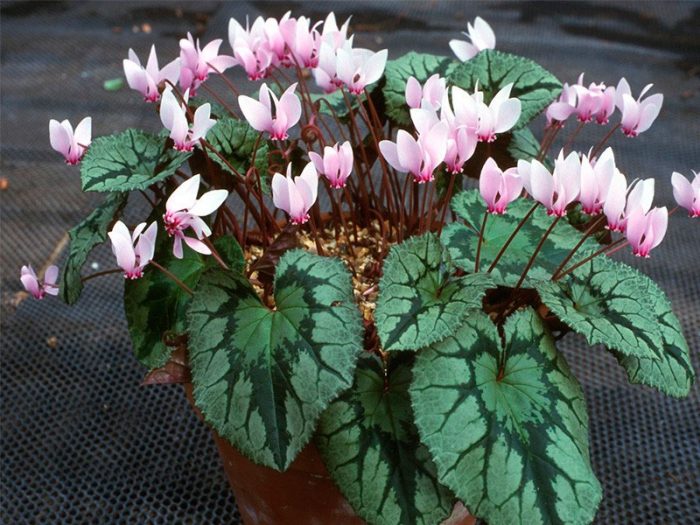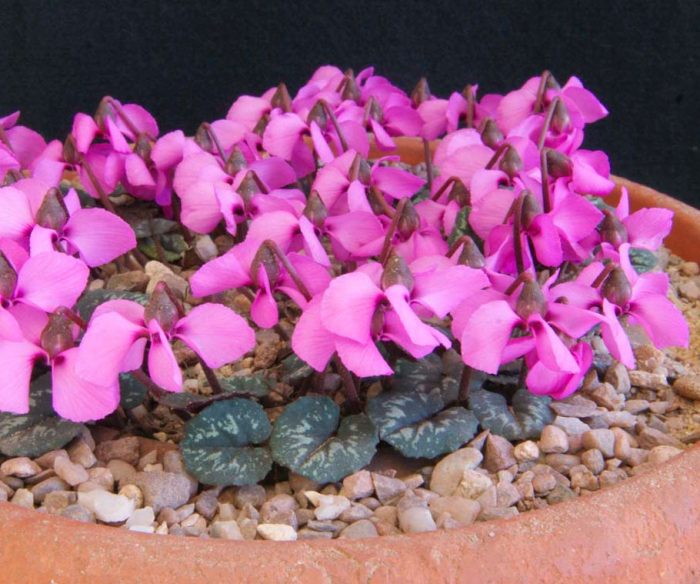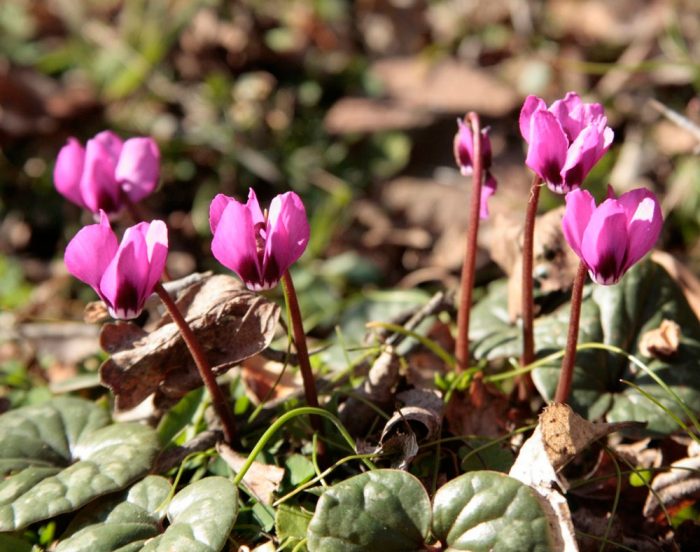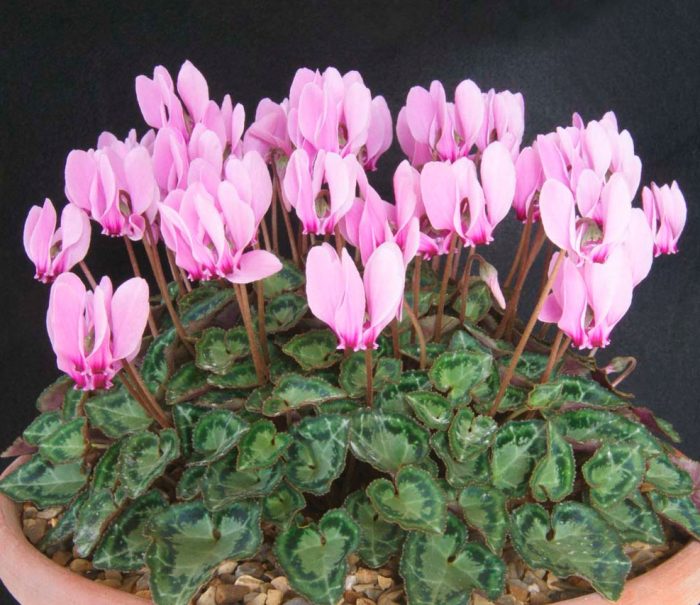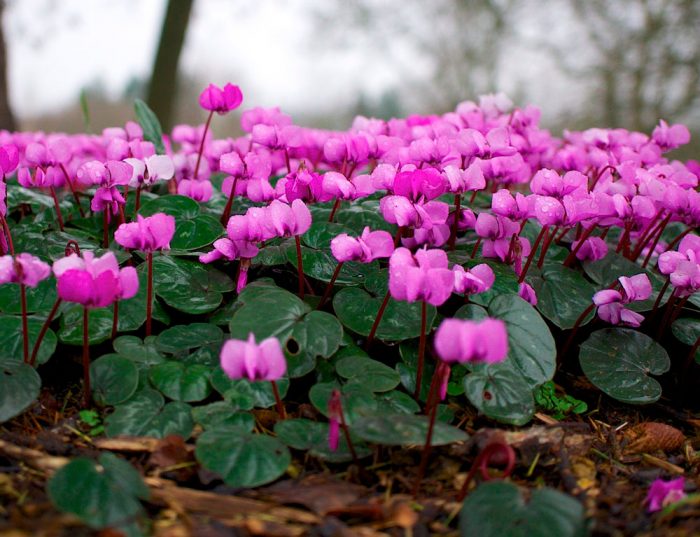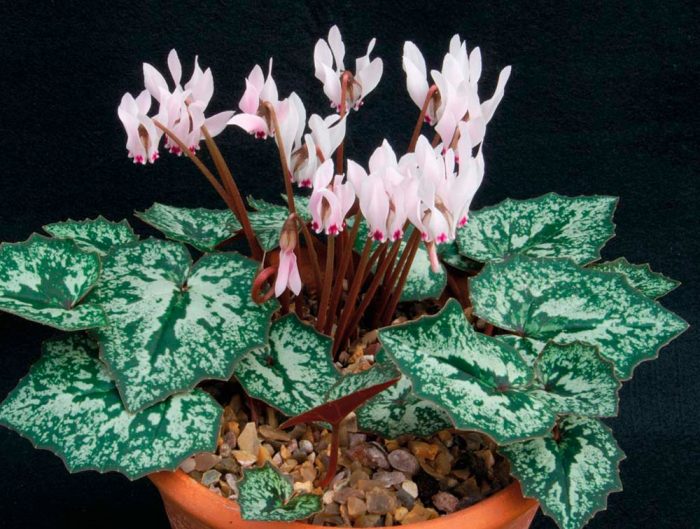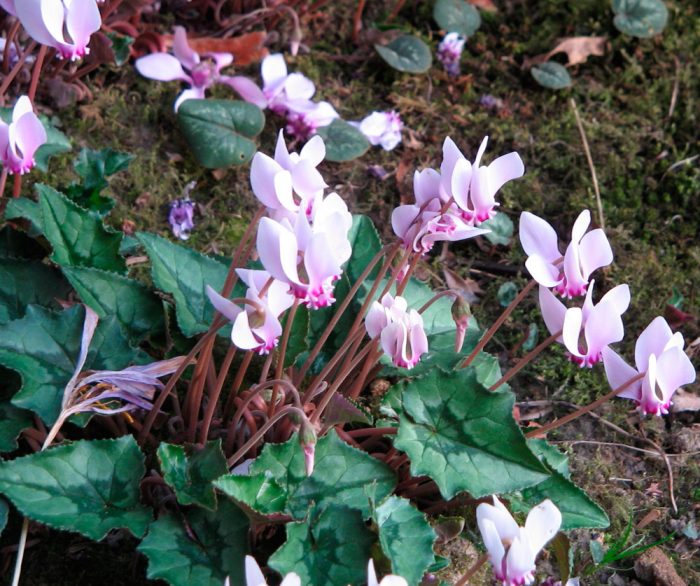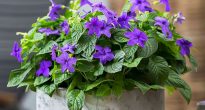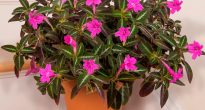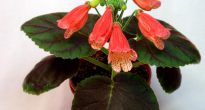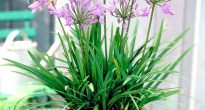The cyclamen plant is part of the primroses family. This genus unites from 20 to 55 species. In nature, the flower is found in the Mediterranean and Central Europe, as well as in Asia Minor.
Representatives of this genus are herbaceous perennial plants. The thick root has a tuberous shape. Green leaf plates growing from the root have long petioles, in some cases they are decorated with a pattern of a silvery shade. Drooping flowers form on high peduncles. Flowering is observed in winter or spring, it depends on the species. It is quite simple to cultivate cyclamen at home, while one bush will delight you with its flowering for many years. However, before growing such a flower, it should be borne in mind that it will normally grow and bloom only in the cool, but if it is hot in the room, then its foliage will fly around, and the flowering will stop. Thanks to breeders, today there are a large number of cyclamen varieties, some of which are perfect for growing indoors.
Content
Brief description of cultivation
- Bloom... As a rule, from the last days of October to March.
- Illumination... The light is diffused, but bright.
- Temperature regime... In summer it is 20-25 degrees, and in winter - 10-14 degrees.
- Watering... Use the bottom watering method. During the flowering period, watered abundantly, and the soil mixture should be slightly damp all the time. When the flowering is over, a gradual reduction in the frequency and abundance of watering is carried out, and after the foliage is completely dry, the soil mixture is moistened only so that it does not completely dry out.
- Air humidity... It should be tall. Before the buds appear, the cyclamens should be systematically moistened with warm water from a sprayer. And after the buds are formed during flowering, the plant, along with the flower pot, is placed on a pallet filled with wet pebbles.
- Fertilizer... From the moment the foliage appears and until the formation of buds, the flower is fed 1 time in 4 weeks with a complex fertilizer for decorative deciduous plants.And after the buds are formed and until the end of flowering, feeding is carried out the same way once a month, but for this, fertilizer is used for flowering indoor plants.
- Dormant period... As a rule, in May – June.
- Transfer... The plant is transplanted every year immediately after foliage appears on the tuber.
- Soil mixture... Peat, humus and sand are taken in one part, and leafy soil - from 2 to 3 parts.
- Reproduction... Tubers and seed method.
- Harmful insects... Grape weevils and cyclamen mites.
- Diseases... Gray rot. Also, problems with the plant can arise if it is improperly looked after or if optimal conditions for growth are not provided.
- Properties... The tubers of such a plant contain poisonous juice, it can cause diarrhea, vomiting and seizures.
Cyclamen care at home
Illumination
In order for the cyclamen to grow and develop fully, it needs proper lighting. Best suited for this flower is a western or eastern window sill. Since the direct rays of the sun can harm the plant, if you have to put it on the southern windowsill, choose a place for it away from the window or shade it. The northern window is not suitable for a flower, as there is very poor lighting.
Temperature regime
In winter, normal development and lush flowering of cyclamen is possible only if the air temperature is within 10-14 degrees. In the warm season, the optimum temperature for such a plant is 20-25 degrees.
Watering
Water the flower with soft water, the temperature of which is 2 degrees below room temperature. It is collected in a container 24 hours before watering and allowed to settle well. Watering should be abundant throughout the flowering period. Avoid overdrying the substrate in the pot, and also make sure that no liquid stagnates in it. For cyclamen, bottom watering is well suited (through a sump), in this case, water will not get on the tuber, core and buds of the bush. When the plant is watered, after 2-3 hours, be sure to pour excess water from the pan. At the end of flowering, watering is reduced, and when all the foliage is completely dry, and the tuber is also exposed, watering should become very scarce and rare.
Air humidity
In order to increase the humidity of the air, the bush is moistened from a spray bottle, using rain or well-settled water for this. However, a similar procedure can be carried out only before the formation of buds, and after that, to increase the humidity level, another method is used: wet peat or pebbles are poured into the pallet and a flower pot is placed on it. Make sure that the bottom of the container does not come into contact with water.
Fertilizer
You need to start feeding the flower from the moment the leaves appear, for this they use a complete mineral or organic fertilizer. As soon as flowering begins, all feeding is stopped. Remember that if there is too much nitrogen in the substrate, then this can lead to rot on the tuber.
Dormant period
As soon as the foliage begins to dry out and die off the flower, this indicates that a period of dormancy begins. Reduce the frequency, as well as the abundance of watering, and this should be done gradually. And when the plant is completely bare, it is watered sparsely and infrequently.
The room where the plant is located is systematically ventilated. If possible, transfer it to a balcony that is shaded from the sun. In August or September, the bush is transferred to a well-lit place and begins to gradually increase watering. During the dormant period, the flower at home can be stored in another way: when the bush fades, watering is reduced, and when all the foliage dies off, the pot should be turned 90 degrees and in this position it will be stored until the last summer or first autumn weeks ...
Bloom
A cyclamen grown at home is capable of blooming magnificently for up to fifteen years in a row, while annually up to 70 spectacular flowers will form on it. After the flowers wither, they, together with the peduncle, are carefully pinched off near the tuber, it is highly undesirable to cut them off. Then the rupture site is treated with powdered charcoal.
Cyclamen transplant
The transplant is carried out annually in August or September, and this is done after the first foliage appears from the tuber. Choose a wide container for transplanting, and fill it with a loose substrate with a pH of 5.5–6. The approximate composition of the soil mixture: humus, sand and peat (one part at a time), and also leafy soil (2 or 3 parts). You can also use a substrate of the following composition: sand, humus and leafy soil (1: 2: 4). If the pH of the soil mixture is higher than 6.5, then the likelihood that the plant will be affected by fungal diseases increases.
After the bush is removed from the pot, cut off all rotten roots, while trying not to injure healthy ones. When planting a tuber, keep in mind that it should rise by half or a third above the soil mixture, thanks to this, the flowering of the cyclamen will be more magnificent. To avoid stagnant water in the root system, do not forget to make a good drainage layer at the bottom of the container.
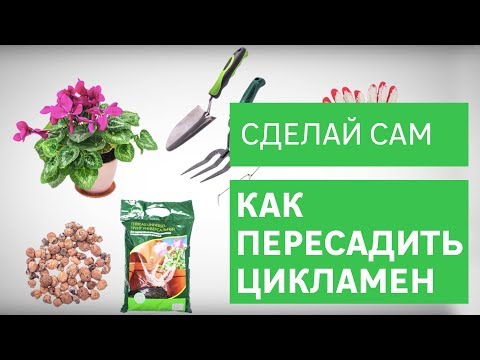

Watch this video on YouTube
Virulence
In the juice of any part of the Persian cyclamen bush, as well as its tuber, there are poisonous substances that can cause diarrhea, convulsions and vomiting.
How is cyclamen useful?
An infusion is prepared from cyclamen, which is used for colic, rheumatism, neuralgia, indigestion and flatulence.
Growing from seeds
Seed collection
In order to collect seeds from an indoor cyclamen, artificial pollination is required. To do this, take a brush with soft bristles and transfer pollen from the flower of one bush to the flower of another. If there is only one bush, then the pollen is transferred from flower to flower in the same way. For this procedure to be as effective as possible, it should be carried out on a sunny morning, and it will need to be repeated more than once. Also, fertilizing the bush with a nutrient solution will have a positive effect on fruit setting (per liter of water, 0.5 grams of potassium sulfate and 1 gram of superphosphate). Remember that drying the seeds after harvesting negatively affects their germination. The quality of the seed on sale in the store directly depends on the batch.
Sowing and care
Sowing seeds is carried out in the last days of August. To begin with, they are immersed in a sugar solution (5%), and then all the seeds that have surfaced are thrown away. You can sow only those seeds that are at the bottom of the glass with the solution. Then the seed is kept in Zircon solution for some time. Fill the container with a moistened soil mixture (sand and peat (1: 1) or peat and vermiculite (1: 1)), and then evenly place the seeds on its surface, sprinkle them with a layer of the same soil mixture, and its thickness should be about 10 mm. From above, the container is covered with plastic wrap, which should be opaque, do not forget to carry out systematic watering and airing. The air temperature where the crops are located can vary from 18 to 20 degrees.
The first shoots should appear in 1–1.5 months. As soon as this happens, the shelter is removed to a cooler place (from 15 to 17 degrees), which should be well lit, but protected from direct sunlight. When small nodules and 2 or 3 leaf plates appear, the seedlings are picked into pots filled with a soil mixture consisting of peat, sand and leafy soil (2: 1: 4). During transplantation, the nodules should be completely sprinkled with soil mixture. 7 days after transplanting, it is recommended to feed the young bushes; for this, use a flower fertilizer diluted in half. In the last spring weeks, seedlings are transplanted into individual containers, and their first flowering should occur at about the fifteenth month of growth.
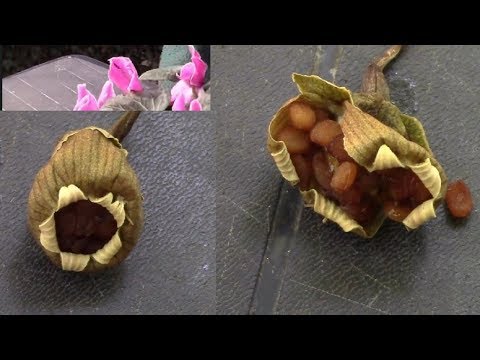

Watch this video on YouTube
Possible problems
- Cyclamen leaves turn yellow. If the cyclamen is watered with excessively hard water, then yellowing of its foliage may begin, and the color of its petioles does not change.
- The appearance of rot... If the drainage is not good enough, then a systematic stagnation of liquid can be observed in the soil mixture, which often leads to the development of rot on the tubers.
If watering is very abundant, then the petioles of the leaf plates, as well as the peduncles, rot, and this becomes the cause of the death of the cyclamen. - Flying around foliage... Yellowing and flying around of the leaf plates is observed if the room is very hot and the air is excessively dry.
- Gray rot... The bush infects gray rot when it is in a cool room that is not ventilated.
- Pests... If a cyclamen tick has settled on a flower, then it must be destroyed. You can understand that the bush is affected by this pest by the following symptoms: the foliage becomes smaller and its shape changes, the curvature of the peduncles and wilting of flowers are observed, the buds bend at the same time.
A grape weevil can also settle on the plant. Because of it, the cyclamen shoots break and die off. Be sure to check the substrate for weevil larvae.
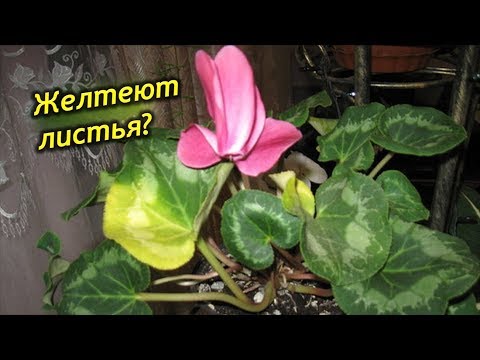

Watch this video on YouTube
Types of cyclamen with photos and names
Persian cyclamen (Cyclamen persicum)
This type of cyclamen is widespread in parts of Africa, Asia and Western Europe (Ethiopia, Cyprus, Sudan, Italy and Iran). Such a flower grows normally in countries where the weather is moderately cool in winter, for example, in northern Italy, and its bloom is observed in winter.
It is known that in ancient times, healers used such a plant for rheumatism, sinusitis and diseases of the central nervous system. It also helped with snake bites. The species blooms for a very long time, throughout almost the entire growing season. Some of the varieties in the summer can throw off the foliage. This species actively grows and develops from 3 to 4 months, and the rest of the time it has a dormant period.
The heart-shaped leaf plates are dark green and decorated with a marbled white pattern. The color of the flowers can be different, for example: white, pink, purple and red. In a tuber, cyclamen accumulates a supply of various mineral and organic substances. And he spends these substances during the rest period. Under natural conditions, if the flowering of a plant is observed in winter, then organic substances are simply necessary for it.
There are a large number of Persian cyclamen hybrids that were bred by Dutch breeders. The flowering period in hybrids is longer. And the flowers of hybrid cyclamens can be colored in different shades. For example, cyclamen of the Persian series "macro" has 18 different colors. Moreover, the bush of such a hybrid is larger, and it blooms longer than the species plant.
Cyclamen European, or blushing
This species is most often found in nature in Central Europe (Slovenia, northern Italy and Macedonia). Such a herbaceous plant is evergreen. Its tuber has a flat-round shape (slightly flattened) and a single growth point. Over time, the tuber deforms, and thick shoots appear with their own points of growth. Basal leaf plates are colored silvery-green. Their shape is heart-shaped with a pointed apex and a slightly serrated edge. The seamy surface of the leaves has a greenish-purple color. Single five-petalled flowers are formed on high peduncles. The petals are oval, slightly twisted into a spiral. The peculiarity of this species is that the aroma of its flowers is strong, but delicate.
This species blooms throughout the growing season (from spring to autumn). Its flowers can be pinkish, purple-pink, pale purple or deep purple.
This species has a very popular cultivar purpurascens, which has spectacular flowers of pinkish-purple or burgundy hue. The word "purpurascens" from Latin is translated as "purple". Also, breeders were able to breed other varieties that differ in flower color and flowering duration, for example:
- carmineolineatum - the color of the flowers is white;
- lake garda - flowers are painted pink;
- album - spectacular white flowers.
Cyclamen African
This type is very popular with flower growers. He comes from Algeria and Tunisia, but prefers to grow in bushes. This type is outwardly similar to ivy cyclamen.
There are 2 forms of this type of cyclamen: tetraploid and diploid. In the diploid form, the leaf plates are smaller, and the petioles can have different shapes, and it also has more fragrant flowers. In room conditions, as a rule, the diploid form of this cyclamen is grown. Its foliage is heart-shaped, and they are painted in a greenish-silvery shade. Leaf plates grow directly from the tuber, while they can reach about 15 centimeters in length. This is considered the main difference between this species and ivy cyclamen. Flowering begins in spring and ends in autumn, while the appearance of new foliage occurs only in September – November. Flowers can be colored in various shades from deep pink to light pink.
When growing African cyclamen, remember that it contains substances that are toxic to cats and dogs. This species is notable for its low frost resistance, therefore, it needs a special shelter for the winter. It can also be harmed by direct sunlight. This species differs from other representatives of the Mirsinovy subfamily by its rapid growth and development. After the bush has thrown off the foliage, it is recommended to rearrange it in a dry place with an air temperature of about 15 degrees.
Alpine cyclamen (Cyclamen alpinum)
Alpine cyclamen has a very confusing history. It was discovered and entered in the list of plants of the Mirsinov family at the end of the nineteenth century. However, over the years, alpine cyclamen began to be considered an extinct species, this continued until 1956. For a long time the epithet "alpinum" was used in relation to cyclamen intaminatium. This led to confusion in terms, so the experts introduced a new name for the alpine cyclamen - cyclamen trochotherapy. This term is still used today by a large part of specialists, despite the fact that Davis denied the disappearance of the Alpine cyclamen in the early sixties. As many as 3 expeditions were sent to research this type of cyclamen in the early 2000s. As a result, it was confirmed that this type of cyclamen is found in natural conditions today.
In this plant, unlike other species, the petals on the flower are located at an angle of 90 degrees, and not 180 degrees, as usual. They are painted in various shades from pinkish to carmine pink, and at the base of each petal there is a speck of purple. The flowers have a delicate pleasant scent that is similar to that of fresh honey. Oval leaf plates are colored greenish-gray.
Cyclamen Colchis or Pontic
This species comes from the mountains of the Caucasus. Colchis cyclamen is also called Caucasian, Pontic or Abkhazian. When grown indoors, flowering is observed from July to the last days of October, and in natural conditions - from the first days of September to the second half of October. This species can often be found in the mountains at an altitude of 300 to 800 meters among tree roots. The appearance of flowers and leaves in a given plant occurs simultaneously. Elliptical slightly curved petals have a dark pink color (the shade is darker along the edge), their length can vary from 1 to 1.6 cm. There are roots on the entire surface of the tuber. This species prefers shaded areas with moist soil. It is slow growing and its flowers have a strong but pleasant aroma. Seed material matures within one year.
Due to the fact that Colchis cyclamen is massively used for cutting bouquets, as well as for collecting medicinal raw materials, not so long ago it was listed in the Red Book. Today, there are still quite a few specimens of this type of cyclamen in nature, however, according to experts, its number is noticeably decreasing.
Greek cyclamen
In nature, this kind can be found on the islands of Cyprus, Rhodes and Crete, as well as on the mainland of Greece and on the coasts of Turkey. It can be found at an altitude of 1.2 thousand meters above sea level. Prefers to grow in humid, shaded areas. The shape of the leaf plates can be very different: from oval to heart-shaped. The color of the foliage can also vary from pale lime to dark green; its surface is decorated with characteristic specks of a contrasting grayish or cream shade. Flowers form before foliage or they appear at the same time. Flowers can be colored in various shades from carmine pink to light pink. At the base of the flowers are specks of purple hue. In 1980, a rare subspecies of the Greek cyclamen with white flowers was found on the Peloponnese peninsula, it was included in the Red Book.
Kosky cyclamen
The type of Kos cyclamen was named after the island of Kos, located in the Aegean Sea. This species can be found in nature in the coastal and mountainous regions of Georgia, Syria, Ukraine, Bulgaria, Lebanon, Turkey and Iran. Flowering begins in the last winter or first spring weeks. The appearance of leaf blades occurs in the last autumn weeks, and in some cases in winter. The color of the foliage depends on the type of cyclamen and can be either dark silver or green. Flowers can also be painted in different colors, such as red, pink, purple or white. The petals at the base are painted in a rich shade. In this type of cyclamen, roots grow on the tubers only from below. Experts have discovered patterns in the change in the color of the petals, the size of the flowers and the shape of the leaf plates: plants growing in Syria and southern Lebanon have bud-shaped foliage and pinkish flowers, cyclamens with rich pink flowers grow on the northern coast of Turkey, the further to the east, the the flowers are larger and the foliage is narrower. In the southern regions of Iran and Azerbaijan, cyclamens have large flowers and heart-shaped foliage.
Cypriot cyclamen
This species is one of three plants belonging to the Mirsinov family that can be found on the island of Cyprus. Most often, this species is found in the Troodos and Kyrenia mountains at an altitude of 100 to 1100 meters above sea level. Such cyclamen prefers to grow on rocky ground under trees or shrubs. The height of such a perennial can vary from 8 to 16 centimeters. White or pinkish flowers have a characteristic honey smell. At the base of each petal there are specks of purple or violet color. The shape of the leaf plates is heart-shaped; they can be painted in various shades from olive to dark green. Flowering begins in the last days of September and ends in mid to late winter. This plant is a symbol of Cyprus. As an ornamental plant, such cyclamen is cultivated in a large number of countries.
Cyclamen ivy
This species is most common in mid-latitudes. Most flower growers call this species "Neapolitan", while experts call it "ivy". The plant got its first name “cyclamen hederifolium” in 1789, and the second “cyclamen neapolitanum” - in 1813. When buying such a plant, be careful, as under the guise of Neapolitan cyclamen you may be sold a European one, claiming that it is a subspecies of cyclamen neapolitanum.To expose the deception, you need to know the exact description of the ivy cyclamen.
This species comes from the Mediterranean coast (from Turkey to France). This species differs from the others in its high frost resistance. In the countries of the southern part of Europe, such a plant is used to decorate parks. In middle latitudes, this species is grown exclusively at home.
This cyclamen was named ivy due to the shape of green leaf plates: rounded with small notches, very similar to ivy foliage. The flower is similar in shape to the flower of European cyclamen, but at its base there are spectacular horns. The root system of such a plant is superficial, and the flowers can be painted only pink. But thanks to breeders, many varieties of this type of cyclamen were born. Some varieties are "dwarf", while others bloom from December to March, and some of them have a pleasant, but sharp aroma and spectacular color.
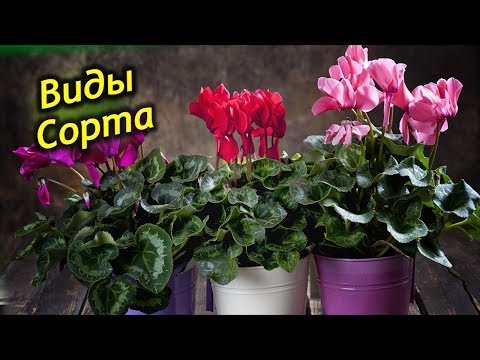

Watch this video on YouTube

